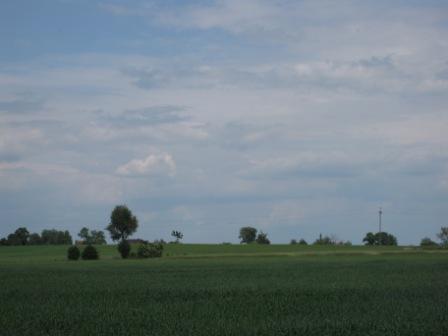
With the help of our wild, fearless driver and founder of the Poznan Project, Lukasz (pronounce that Wu kash), Rebecca, and I were able to track down and visit the relevant villages of the ancestors of Walter Lasecki (pronounce Wah set ski) during three days in June 2012. I wrote a small piece describing a bit of the Polish landscape on this trip here.
Below is a google map of the area. We stayed at the Hotel Pietrak in Wagrowiec. The first day we visited Redgoszcz (east of W.), Lekno (north of Redgoszcz), Laskownica Mala (north and slightly west of Lekno), Rybowo (north and east of Laskownica), Grylewo (north of Wagrowiec), Danaborz, across Lake Gryleskiego from Grylewo, and then Tarnowo, just to visit the ancient wooden church.
Enroute, Lukasz told us that he had relatives in Lekno and we surmised that somewhere in the distant past, we are probably related. I should have known the chemist-turned-genealogist I’d found online would turn out to be a cousin of sorts!

It was a lot of time in the car zipping along very quickly on two-lane country roads, but we made good use of the hours. Lukasz is an incredible font of Prussian genealogical info.and I have endless questions. I pumped him for info. and tried to take photos from the car window while Rebecca acted secretary, creating a detailed record of our finds. It’s unbelievable how much I have forgotten during the one month since we returned home from Poland. R’s records are now invaluable!
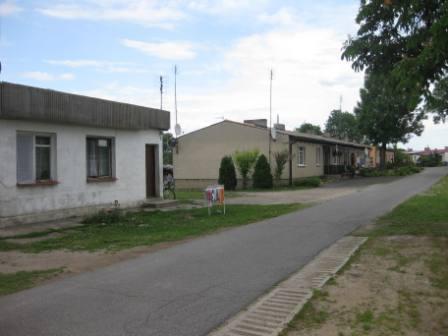
As we neared our next stop, Lekno, we passed

perhaps the last of the windmills in existence when our ancestors lived here. They are evidence of the Dutch, who were the first settlers of the area to drain the marshes and create the rich farmland our ancestors tilled.
Lukasz remembered many still standing when he was a child. Today there are many modern windmills operating. They are also graceful structures dotting the rural Polish landscape, but in a different way. The old one has an ancient patina and aura about it.
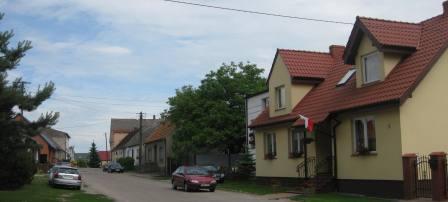
Stop #2 LEKNO Village of Francis Rozmarynowska Lasecki‘s birth. This is the Rozmarynowski ancestral village.
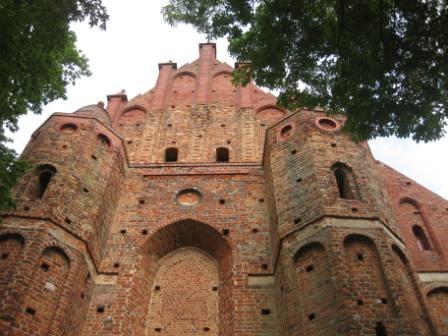
We visited St. Peter and Paul RC Church, built in the 1500s. A beautiful stone grotto of Lourdes graced the churchyard. It reminded me of Rev. Kieber’s Eggertsville parish.
In the entrance to the church, a plaque commemorates pastors killed in Dachau. Nazis murdered many Catholic priests and nuns, naturally leaders of the community, to abolish resistance.
In the altar area, there is a life sized tomb of a noble lord. We surmised that it probably was the one who had the church built.
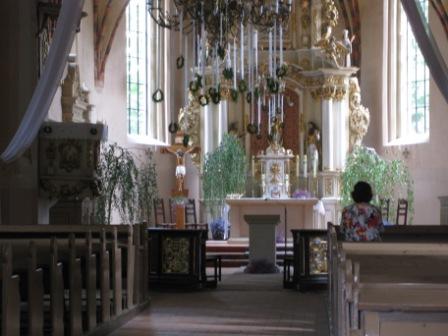
There was a beautiful altar rail and kneeler.
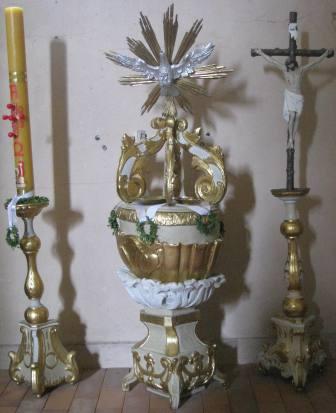
I photographed baptismal font used for my g-great grand mother’s Baptism, then knelt and prayed, asking our ancestors to bless the family.

I was very moved realizing the history and spirituality of our people that was developed here.
Sad, though, to see how much of the church needed restoration.
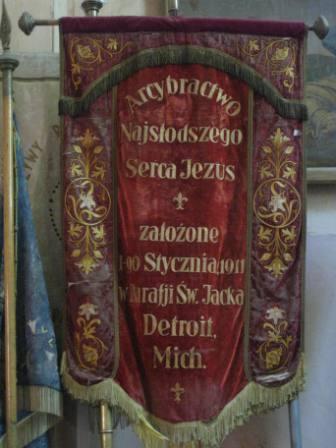
Much of the masonry required attention. Half of the church still had a dirt floor. The obvious piety during Corpus Christi was all the more moving in light of the physical needs of the building.
In the rear of the church, in front of a painting of the Resurrection, were several processional banners. Lukasz translated one from St. Hyacinth’s in Detroit. Evidently someone had brought to Lekno during the 1930s.
Something to connect the Old World with the New! I have since written to St. Hyacinth’s asking if anyone there knew anything about this. The secretary posted it in the weekly church bulletin. Alack and alas, there was no response. If you know anything about the relationship between these tow parishes, we’d love to hear from you.
A note from our conversation with Lukasz: This is NOT the right area for ethnic Kashubians (a linguist suggested that the Laseckis were Kashubian at one point). They were more north along the coast of Poland. But Kashubians and people from the Poznan area, often joined the same parishes in Detroit after emigration and sometimes they started to refer to themselves interchangeably. Eventually they all got mixed up. But Kashubian is a special language, that regular Poles (or us!) need to be trained to understand.
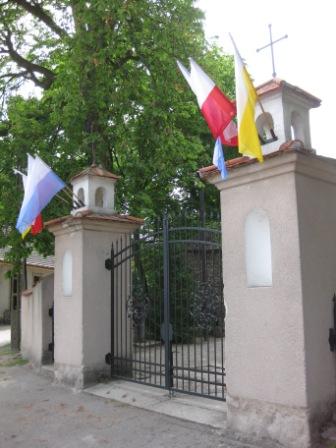
Every church we visited flew three flags: a yellow-white papal flag, a red-white Polish flag and a flag of the particular parish colors.
We drove north to Laskownica, the village where 2 of the Lasecki children were born: Joseph and Josepha.
Lukasz explained that it was typical for laborers, such as Andrej Lasecki to move from village to village, wherever work was available. A very different situation from that in southern Poland, home of the Moraniecs and Garbaczyks. There, the records show stability over several generations, even in the same house!
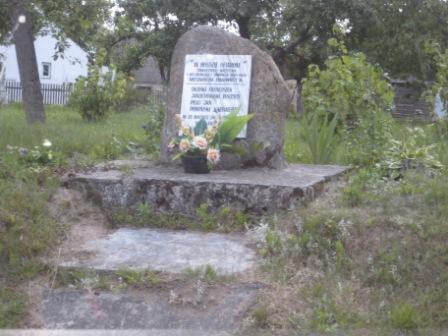
Enroute to Laskownica, we drove by a stone memorial to a group executed by the Nazis in 1939.
We also passed a barn built of clay indicative of the soil in the area. Not surprising, since we weren’t too far from a Boleslawiec factory which produces the famous Polish stoneware I collect.
The manor house, if ever there was one in Laskownica, was no longer standing. The church was built in the 1860s, which would be during the era the Laseckis lived there. However, as we learned later, this was not the primary Lasecki village.
Finding these villages was an amazing adventure in itself. Several, including Danaborz, were accessible ONLY via very rough dirt roads, most not much more than tractor trails through glorious June fields of rye, potatoes, or hay. We drove through tiny Rybowo where Wojciech Dych and Francisca Nowak were married in 1826. We were really in the boonies now! Glad the car didn’t break down 🙂 And did I mention that there weren’t any rest areas for other necessary activities?
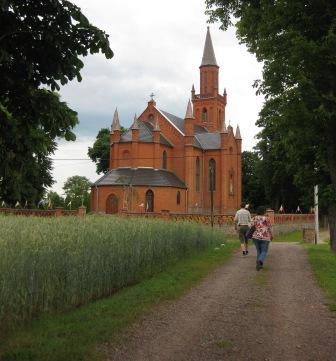
Eventually we made it to Stop #3 Grylewo village where both Antony Lasecki and Michalina Dych were born. This is the Dych ancestral village. There was an old manor house in very poor condition.The church was closed, so we photographed the outside. A grave of Antoni Gertych, the pastor who died in 1875 was in the churchyard. A tree-covered hill sloped down to the Lake Gryleskiego behind the church. A rooster seemed to crow “welcome” as we walked around admiring the architecture, the mulberry and chestnut trees.
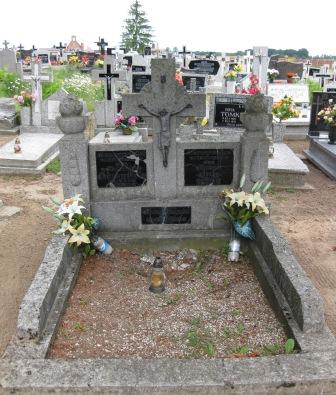
We then went to Grylewo cemetery to see if we could find anything relevant. We found several Dych gravestones including g-grandfather Jan Dych’s brother Thomas Dych’s family. There were recent flower offerings, leading us to believe there are Dych cousins in the area!
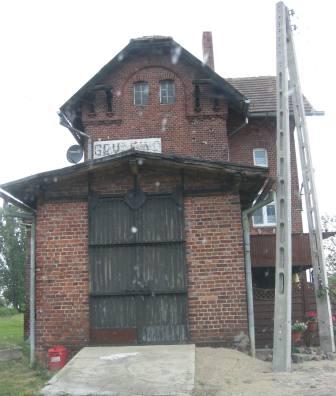
We then stopped at the old Grylewo train station. There was a small, possibly family group, who lived there, sitting outside having tea. We took a photo of the old sign. Looked as if it may have been in German originally. There was much German influence in the entire area. At our hotel, the clerk spoke only Polish and German. At the end of WW1, Lukasz explained, the Germans had all left. After so many years under the German thumb, Poles treated them horribly and though not explicitly stated, they had to leave. Almost an ethnic cleansing. Similar to what happened to the Muslims in India at the end of British rule. Today there are only remnants left of the many many Lutheran churches Germans had erected in Prussia.
Stop #4 a drive-through – Donaborz, Village where Jan Dych was born. This village is ONLY reached via a dirt road through fields of rapeseed, rye, and barley. The village is tiny, few people live here anymore. Rebecca shot a video from the better (really!) of the two dirt roads we were on.

Stop #5 Tarnowo – the wooden church of St. Nicholas is the oldest such church in Poland still in its original form. Some of the church was reportedly from the 1300s, though much was from the 1700s. We arrived in time for Mass, which they have daily at 5 pm. Otherwise, it is closed to the public as are most of the rural churches we visited. After spending some time inside, praying and admiring the magnificent polychrome murals that covered nearly every inch of the wooden interior, we left in awe of the continuity of that faith community.
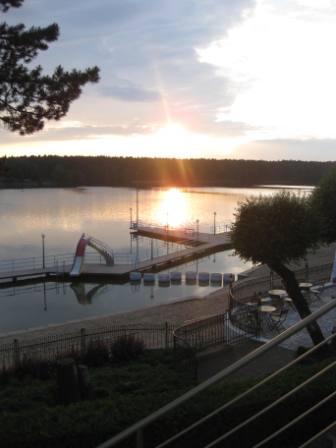
We returned to the hotel and enjoyed dinner on the terrace and a stroll along the Lake Durow before retiring.
The adventure continues on Day Two of Lasecki Land and on Lasecki Land Day 3.
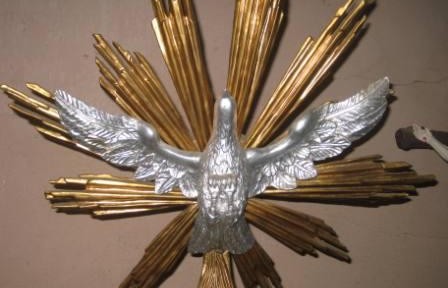
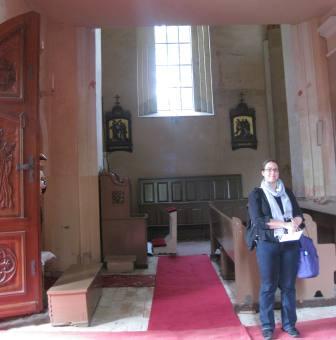
7 responses to “Lasecki Land, day one”
Great post, Carolyn! I love the pictures of course but would not be able to truly appreciate them if not for your helpful narrative. Can’t wait for Bobrowa!
J., Glad you enjoyed. Yes, Bobrowa is in the works. These posts take an incredibly looooong time to create, but am working diligently to get them completed. By the way, working this summer with a cousin recently who has photos of the Moraniec bunch she shared. Will be posting those as well. Sorry to say, none of Lucy or Michael….but Chester, yes! PS am planning a trip to A2 in a couple of weeks to visit Beck who is teaching there this summer. I’d like to return to the Burton collection. Perhaps we can get together? Hugs to you, cuz.
Dear Carolyn,
Just ran across your post regarding Lekno. It is the ancestral village of my paternal g-grandfather (Michael Mantych). He and his wife (Antoinette Krus) were married in Lekno in 1873. After reading your post, I would like to think in Sts. Peter & Paul church. Michael’s parents, Joannes Mantych & Anna Howoska, were married in Lekno in 1842. Our last name is not distinctly “Polish” and my grandmother said that my grandfather’s family was Dutch. As an adult, I thought perhaps she really meant “Deutsch”, as that area was under German/Prussian rule for so many years. But after seeing your photo of the “Dutch” windmill, I would like to think she was correct all along. Would love to know more of the Dutch history of the area. Michael & family immigrated to Southern Il around 1881. It appeared that Joannes’ sister Magdalena married Laurentius Nowak in 1849 and his daughters, Josepha married Joannes Grams in 1864 and Catharina married Stanislaus Krus in 1865. Thanks for posting the wonderful pictures. It brought tears to my eyes that this is where my family stood.
Judy, So glad that the pics were meaningful to you. Being there sure was to me!!! I often wonder why it is that we are so moved to see and know where our family was from.
I have both Nowaks (which is very common, like Smith, in Poland) and Krus. Do you have any more info about your Krus line? If so, please email me at carolyngrady at gmail dot com. Thank you.
This was very exciting! My ancestors all lived in the tiny Village of Rybowo, Parish of Grylewo, Thomas NOWAK among them. I have searched high and low for even one picture of Rybowo to no avail. I so wanted to get a feel for the landscape and culture of the area. And woe and behold I stumble accidentally upon your site. From the looks of it Rybowo is so tiny that you can travel through it in a blink of an eye. I’m told that Rybowo was a manorial estate owned by Ignacy and Stanislawa Ulatowski in 1793 during the time of the Prussian Partition. It sits near the pond of Rybowo on the lowland plain which boasted of a grammar school and, of course, the nearby railway station and post office. “During the second half of the 19th century the village of Rybowo had 2 houses with 17 inhabitants (16 Catholics & 1 Protestant and had 123 hectares of land (114 of fields and 6 of meadow). The estate had 834 hectares of land (603 of fields 85 of meadow, 95 of forest.). It had a distillery, a poultry/egg farm, a holding space and slaughtering facility for cattle.” It’s history dates back to at least 1523 when Rybowo paid a tithe to the pastor of Grylewo. It is believed that my ancestors, the KURZAWA’s lived in one of the houses on the manorial estate. Thomas NOWAK witnessed the marriage of my great-great grandparents (Marcin Kurzawa and Maryanna Szczepaniak). He was also god-parent to several of the Kurzawa children.
In any event, it gave me such joy to browse your site. Thank you so much for putting it out here for all of us. If you ever return to Rybowo, wave to my beloved ancestors for me. 🙂
Hello to the community, I have been researching the history and family genealogies Myszka from the USA, I looking for connections to UK then to Poland matches during Napoleonic times. I am working on timing all family line back to Poland in the 1300s. One lines genealogy comes from Lesno, Poland from U.S. Census, so from hand written letter passed down to I am looking the Parish of Lekno, Poland record of Birth Marriage and deaths of family members her that also match diocese of Poznań records for 1600 to 1800s.
Thanks for contributing your story here, Michael. Have you been compiling your information or sticking solely to research? If you have written up some stories, I would love to read them.